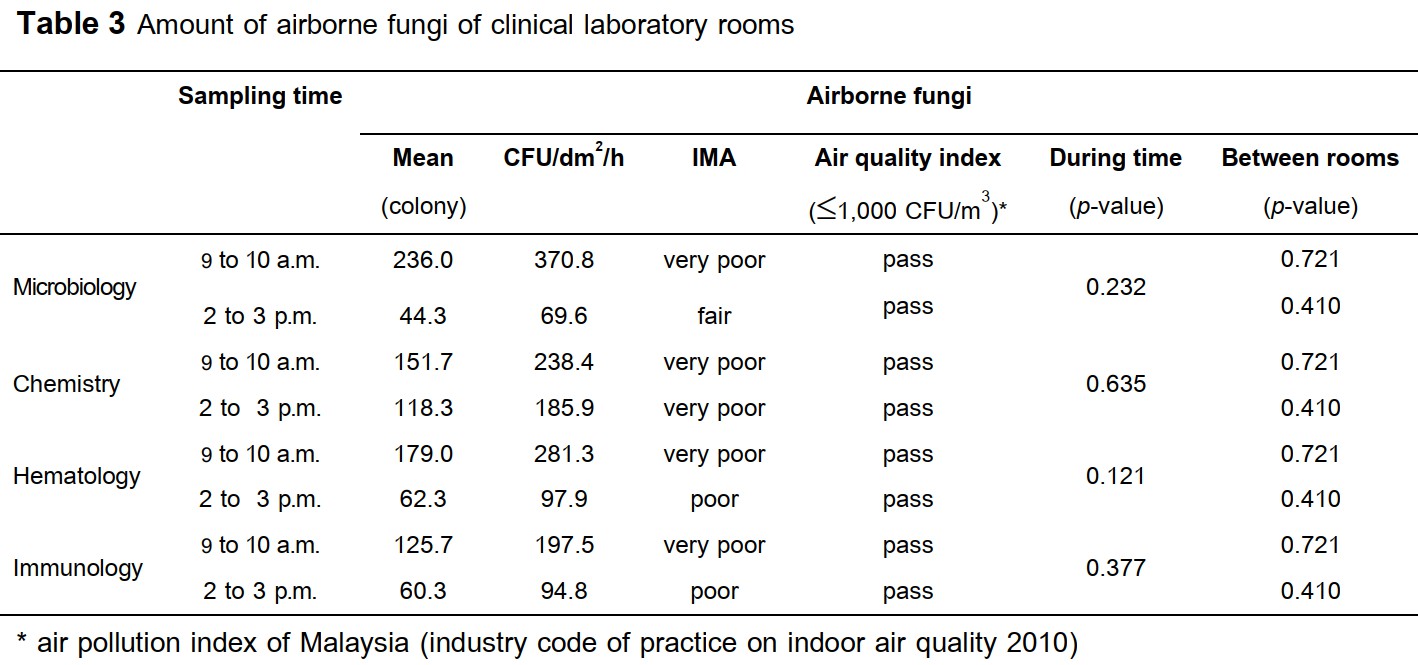Determination of airborne bacteria and fungi in the laboratories of a university
Keywords:
Bacteria, fungi, university’s laboratory, air qualityAbstract
Air quality of indoor environmental is an important factor affect to health of people. The aim of the study was to determine amount and types of airborne bacteria and fungi in the laboratories of a university. The open plate technique was used to collect samples in the morning and afternoon for 3 weeks. The result showed that the average amounts of bacteria and fungi were 67.6 to 340.5 and 69.6 to 370.8 CFU/dm2/h, respectively. The evaluations of the index of microbial air contamination (IMA) were fair to very poor. However, the concentrations of airborne bacteria and fungi were not higher than proposed air quality index. Therefore, air quality of university laboratories had good hygienic standard. Type of bacteria and fungi were found to include Micrococcus spp., gram negative bacilli, Bacillus spp., Penicillium spp., Curvularia spp., Rhizopus spp. and Cladosporium spp., respectively.
References
2. Stryjakowska-Sekulska M, Piotraszewska-Pajak A, Szyszka A, Nowicki M, Filipiak M. Microbiological quality of indoor air in university rooms. Polish J Enviro Stud. 2007;16(4):623-32.
3. Jakkapong N, Sirilak C, Waralee B. Microbial air contamination in laboratory rooms, faculty of science, Payap University. KKU Sci J. 2014;42(2):341-9.
4. Siriporn S, Ganjana N. Ambient microbial contamination in different hospital scales. KKU Res J. 2012;12(1):92-101.
5. Madureira J, Paciencia I, Rufo JC, Pereira C, Teixeira JP, de Oliveira Fernandes E. Assessment and determinants of airborne bacterial and fungal concentrations in different indoor environments: Homes, child day-care centres, primary schools and elderly care centres. Atmos Environ. 2015;109:139-46.
6. Monireh MA, Nemat Allah MA, Iman EM, Farahzad JA, Mohammad TS. Alternaria in patients with allergic rhinitis. Iran Allergy Asthm. 2010;10(3):221-6.
7. Pasquarella C, Pitzurrat O, Savino A. The index of microbial air contamination. J Hosp Infect. 2000;46:241-56.
8. Department of Occupational Safety and Health, Ministry of Human Resources, Malaysia. Industry Code of Practice on Indoor Air Quality 2010.
9. Krisaneeya S. Airborne bacteria and fungi in the hospital and the sampling method comparison. Thai J Health Promot Environ. 2005;29(4):113-224.

Downloads
Published
How to Cite
Issue
Section
License
ผู้นิพนธ์ต้องรับผิดชอบข้อความในบทนิพนธ์ของตน มหาวิทยาลัยพะเยาไม่จำเป็นต้องเห็นด้วยกับบทความที่ตีพิมพ์เสมอไป ผู้สนใจสามารถคัดลอก และนำไปใช้ได้ แต่จะต้องขออนุมัติเจ้าของ และได้รับการอนุมัติเป็นลายลักษณ์อักษรก่อน พร้อมกับมีการอ้างอิงและกล่าวคำขอบคุณให้ถูกต้องด้วย
The authors are themselves responsible for their contents. Signed articles may not always reflect the opinion of University of Phayao. The articles can be reproduced and reprinted, provided that permission is given by the authors and acknowledgement must be given.







